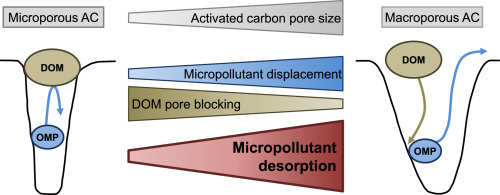Water Research ( IF 11.4 ) Pub Date : 2018-01-11 , DOI: 10.1016/j.watres.2018.01.015 Geert Aschermann , Frederik Zietzschmann , Martin Jekel

|
By simulating decreasing inflow concentrations, the extent of desorption of organic micropollutants (OMP) from three activated carbons (AC) was examined in laboratory batch tests. The tested AC showed strong differences in pore size distribution and could therefore be characterized as typical micro-, meso- and macroporous AC, respectively. Adsorption and desorption conditions were varied by using drinking water (containing dissolved organic matter (DOM)) and DOM-free pure water as background solutions to examine the influence of DOM on OMP desorption for the different AC. Under ideal conditions (adsorption and desorption in pure water) adsorption of the tested OMP was found to be highly up to completely reversible for all tested AC. Under real conditions (adsorption and desorption in drinking water) additional DOM adsorption affects desorption in different ways depending on the AC pore structure. For the micro- and mesoporous AC, an increased irreversibility of OMP adsorption was found, which shows that DOM adsorption prevents OMP desorption. This could be referred to pore blockage effects that occur during the parallel adsorption of DOM and OMP. For the macroporous AC, DOM adsorption led to an enhanced OMP desorption which could be attributed to displacement processes. These results show that smaller pores tend to be blocked by DOM which hinders OMP from desorption. The overall larger pores of the macroporous AC do not get blocked which could allow (i) OMP to desorb and (ii) DOM to enter and displace OMP.
中文翻译:

溶解有机物和活性炭孔隙特征对有机污染物解吸的影响
通过模拟降低的流入浓度,在实验室分批测试中检查了有机微量污染物(OMP)从三种活性炭(AC)的解吸程度。所测试的AC在孔径分布上显示出很大的差异,因此可以分别表征为典型的微孔,中孔和大孔AC。通过使用饮用水(包含溶解的有机物(DOM))和不含DOM的纯水作为背景溶液来改变吸附和解吸条件,以检查DOM对不同AC对OMP脱附的影响。在理想条件下(在纯水中吸附和解吸),发现所有测试AC的被测OMP吸附高度可完全逆转。在实际条件下(饮用水中的吸附和解吸),额外的DOM吸附会根据AC孔结构以不同方式影响解吸。对于微孔和中孔AC,发现OMP吸附的不可逆性增加,这表明DOM吸附阻止了OMP的解吸。这可以称为在DOM和OMP平行吸附过程中发生的孔堵塞效应。对于大孔AC,DOM吸附导致OMP解吸增强,这可归因于置换过程。这些结果表明,较小的孔倾向于被DOM堵塞,这阻碍了OMP的解吸。大孔AC的整体较大孔不会被堵塞,这可能使(i)OMP解吸和(ii)DOM进入并置换OMP。对于微孔和中孔AC,发现OMP吸附的不可逆性增加,这表明DOM吸附阻止了OMP的解吸。这可以称为在DOM和OMP平行吸附过程中发生的孔堵塞效应。对于大孔AC,DOM吸附导致OMP解吸增强,这可归因于置换过程。这些结果表明,较小的孔倾向于被DOM堵塞,这阻碍了OMP的解吸。大孔AC的整体较大孔不会被堵塞,这可能使(i)OMP解吸和(ii)DOM进入并置换OMP。对于微孔和中孔AC,发现OMP吸附的不可逆性增加,这表明DOM吸附阻止了OMP的解吸。这可以称为在DOM和OMP平行吸附过程中发生的孔堵塞效应。对于大孔AC,DOM吸附导致OMP解吸增强,这可归因于置换过程。这些结果表明,较小的孔倾向于被DOM堵塞,这阻碍了OMP的解吸。大孔AC的整体较大孔不会被堵塞,这可能使(i)OMP解吸和(ii)DOM进入并置换OMP。对于大孔AC,DOM吸附导致OMP解吸增强,这可归因于置换过程。这些结果表明,较小的孔倾向于被DOM堵塞,这阻碍了OMP的解吸。大孔AC的整体较大孔不会被堵塞,这可能使(i)OMP解吸和(ii)DOM进入并置换OMP。对于大孔AC,DOM吸附导致OMP解吸增强,这可归因于置换过程。这些结果表明,较小的孔倾向于被DOM堵塞,这阻碍了OMP的解吸。大孔AC的整体较大孔不会被堵塞,这可能使(i)OMP解吸和(ii)DOM进入并置换OMP。











































 京公网安备 11010802027423号
京公网安备 11010802027423号